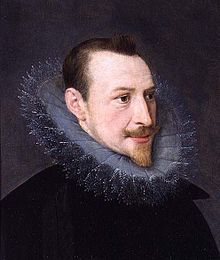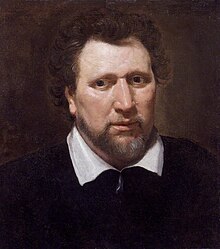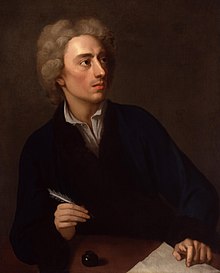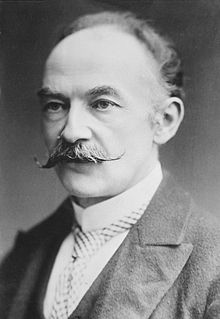English language poetry
The English-language poetry includes any poetry in the English language .
Old English poetry
In the old English epic Beowulf , a scope sings about the creation of the world. The poem “The Dream Face of the Cross” is carved on the Ruthwell Cross in the dialect of the early North Humbrian. Cædmon is considered the first poet . The poem The Battle of Maldon can be dated to the 11th century . After the Christianization of England, numerous religious poems were written, with some elegies such as The Wanderer still noticeable the upheavals of the time. The natural poem The Seafarer , on the other hand, contains both pagan and Christian motifs. Another well-known lyricist is Cynewulf , who wrote the religious poems The Ascension and The Fates of the Apostles , among others .
Middle Ages and Modern Times

After the conquest of England by Norman troops in 1066, the Latin and Norman French of the new elites minorized Old English as the general language of literature. That is why Middle English poetry has neither “large, important collective manuscripts”, nor does it impress with a wide range of lyrical genres. The work Brut by the poet Layamon , written in Middle English , is one of the most important poems of the 13th century. It is not only interspersed with Anglo-Saxon vocabulary, but also marks the beginning of Arthur’s literary reception in England, which also includes the well-known poem Sir Gawain and the Green Knight . Allegories and poems such as Piers Plowman , Patience and Pearl emerged in the 14th century . As a form innovator, Geoffrey Chaucer finally replaced the Germanic allotted rhyme with the end rhyme in the second half of the 14th century and adapted the originally French ballad verse to the English language. This Rhyme royal consists of seven verses, iambic five-headers ( heroic verses ) with the rhyme scheme [ababbcc]. The strong impact of Chaucer is particularly evident in the large number of his imitators, such as John Gower , John Lydgate and John Hoccleve . Even the Scottish King James I wrote poems in the style of Chaucer.
Parlement of Foules
The lyf so short, the craft so long to
lerne , Th'assay so hard, so sharp the conquerynge,
The dredful joye alwey that slit so yerne:
Al this mene I by Love, that my felynge
Astonyeth with his wonderful werkynge
So sore, iwis, that whan I on hym thynke
Nat wot I wel wher that I flete or wynke.
Geoffrey Chaucer verses 1-7
Renaissance
Sir Thomas Wyatt wrote the first sonnets in English in the 16th century . Sir Phillip Sidney sonnet cycle Astrophel instead of the English sonnet, which was already laid out in Wyatt's poetry, finally established itself. In addition, the Jesuit Robert Southwell wrote religious poems and Thomas Campion songs. The English sonnet poetry was to find its climax under William Shakespeare . Other sonnet writers are Walter Raleigh , Michael Drayton and Samuel Daniel . Edmund Spenser composed the verses The Shepheardes Calender and The Faerie Queene .
Sonnet 130
My mistress 'eyes are nothing like the sun
Coral is far more red than her lips' red;
If snow be white, why then her breasts are dun;
If hairs be wires, black wires grow on her head.
I have seen roses damask'd, red and white,
But no such roses see I in her cheeks;
And in some perfumes there is more delight than
in the breath that from my mistress reeks.
I love to hear her speak, yet well I know
That music hath a far more pleasing sound;
I grant I never saw a goddess go;
My mistress, when she walks, treads on the ground:
And yet, by heaven, I think my love as rare
As any she belied with false compare.
William Shakespeare
Baroque
In the 17th century, John Donne's metaphysical poetry was distinguished from the rigid sonnet poetry of the English Renaissance . In contrast, the Cavalier poets Ben Jonson , Richard Lovelace and Edmund Waller took on secular subjects. In the late 18th century, Thomas Gray and Robert Burns overcame the effects of the Restoration, which mainly consisted of the translation of Latin classics, and Burns , the later national poet of Scotland, in particular, paved the way for Romanticism.
Death Be Not Proud
Death be not proud, though some have called thee
Mighty and dreadful, for, thou art not so,
For, those, whom thou think'st, thou dost overthrow,
Die not, poore death, nor yet canst thou kill me.
From rest and sleepe, which but thy pictures bee,
Much pleasure, then from thee, much more must flow
And soonest our best men with thee doe goe,
Rest of their bones, and souls deliverie.
Thou art slave to Fate, Chance, kings, and desperate men,
And dost with poyson, warre, and sicknesse dwell,
And poppie, or charmes can make us sleepe as well,
And better then thy stroake; why swell'st thou then;
One short sleepe past, wee wake eternally,
And death shall be no more; Death, thou shalt them.
John Donne
classicism
The greatest poet of the Augustan Age was Alexander Pope .
Windsor Forest
Thy forests, Windsor! and thy green retreats,
At once the Monarch's and the Muse's seats,
Invite my lays. Be present, sylvan maids!
Unlock your springs, and open all your shades.
Granville commands; bring your aid O Muses!
What Muse for Granville can refuse to sing?
The groves of Eden, vanish'd now so long,
Live in description, and look green in song:
These, were my breast inspir'd with equal flame,
Like them in beauty, should be like in fame.
As any she belied with false compare.
Alexander Pope verses 1-10
romance

English Romanticism began with the publication of the Lyrical Ballads by William Wordsworth and Samuel Taylor Coleridge in 1798. In the foreground of romantic poetry was the confrontation of nature and culture, and while in previous centuries the ego referred to an organizing authority, the romantics discovered their natural surroundings. This attitude was also reflected in the language, where poetic paraphrases, which were still important in classicism and have long since degenerated into phrases, were given up in favor of a natural and sober language. A year after the appearance of the Lyrical Ballads , Wordsworth was working on his magnum opus The Prelude , an autobiographical poem in blank verse . The solitaire William Blake wrote the Songs of Innocence and of Experience. As a painter, he illustrated his poems himself, but was not successful because of the small number of pieces. In addition to the Irish Thomas Moore , the second generation mainly includes John Keats , Lord Byron and Percy Bysshe Shelley .
Ode to a Nightingale
My heart aches, and a drowsy numbness pains
My sense, as though of hemlock I had drunk,
Or emptied some dull opiate to the drains,
One minute past, and lethe wards had sunk,
'Tis not through envy of thy happy lot,
But being too happy in thine happiness, -
That thou, light-winged Dryad of the trees,
In some melodious plot
Of beechen green, and shadows numberless,
Singest of summer in full-throated ease.
John Keats verses 1-10
Victorian era
Victorian poetry was in the tradition of romanticism. Mystification was preferred to an examination of the present; traditional forms of poetry such as the sonnet gained popularity. Despite, perhaps precisely because of the lack of a sense of reality, poetry of the Victorian era reached a wide readership. The once independent poem was now increasingly integrated into poetry cycles, at the same time the genre boundaries were expanded through the dramatization of the poems, which should eventually lead to the genre of the dramatic monologue , the most important representatives of which are Alfred Tennyson and Robert Browning . Mythological subjects compete in Tennyson's poetry with a high degree of reflection and intertextuality. Browning is considered a master of dramatic dialogue. His heroes are often active and great individuals. His future wife Elizabeth Barrett Browning , who was a recognized poet even before marriage, wrote love poetry, among which the Sonnets from the Portuguese can claim special emphasis. Dante Gabriel Rossetti worked as a painter and poet, starting with John Keats he wrote a sensual love poetry, while his younger sister Christina Rossetti is best known today for her children's poetry.
The imperial age forced a stoicist mentality, which interpreted the conquest of large parts of the world as a service to progress and the motherland, while at the same time foreign peoples were robbed of their integrity and living conditions. Stoicism also had a stabilizing effect on the personal emotional balance and supported the social expectations of the time. In 1854, Tennyson recorded in The Charge of the Light Brigade the bravery of the light English cavalrymen in the battle of Balaklava , while Rudyard Kipling's If— (1895) urged self-sufficiency and serenity in strongly rhythmic and swearing words close to the people. Kipling's poems acquired literary historical significance because of the imperial self-image they express, while the aesthetic significance of his ballads lies in the realistic, sometimes sententious verses that serve to proclaim clear messages. A similar affirmation of perseverance is represented in the poem Invictus by William Ernest Henley .
Parting and Morning
Round the cape of a sudden came the sea,
And the sun looked over the mountain's rim:
And straight was a path of gold for him
And the need of a world of men for me
Robert Browning
The main exponents of nonsense literature are Edward Lear , whose main work A book of nonsense appeared in 1846, and Lewis Carroll . The poem Jabberwocky is one of the most famous poems in nonsense literature. Hans-Dieter Gelfert sees nonsense poetry as the only internationally successful poetry of the Victorian era.
There was an Old Man with a beard
There was an Old Man with a beard,
Who said, 'It is just as I feared!
Two Owls and a Hen,
Four Larks and a Wren,
Have all built their nests in my beard!
Edward Lear from Book of Nonsense.
Symbolism as a pan-European trend hardly met with approval. In addition to Rossetti, Algernon Charles Swinburne should be mentioned as a contemporary poet. In his melodic, sensually overheated verses he expressed the self-destructive, everlasting power of desire as well as the lack of permanence of beings. His controversial poet personality contributed to its high contemporary recognition among European poet colleagues. Ernest Dowson's poems from Verses (1896) addressed to young girls are about love that is always threatened and only possible in the moment . Arthur Symons , under the influence of the French symbolists, wrote the two volumes of poetry Silhouttes (1892) and London Nights (1895) in his middle creative period , in which he thematized in impressionistic tones the life of bohemians, intoxication and urban erotic pleasures. What all three great poets of English aestheticism have in common is that their early work is far superior to later works. Swinburne's style degenerated into manner and lacked a subjective urgency despite claims to the contrary, Dowson repeated himself during his lifetime and Symons later turned to post-romantic poetry in recognition of the hostile tendency of decadence poetry. Poets of the following generations, such as TS Eliot and Dylan Thomas, received symbolism in part with a sharp distinction from Victorian poetry.
Clair de Lune
In the moonlit room your face,
moonlight-colored, fainting white,
And the silence of the place
Round about us in the night,
And my arms are round about you
In the silence of the night.
Arthur Symons: Claire de Lune from London Nights, 1st verse.
Edwardian era
Regardless of their independence, the Edwardian Age only lasted until the beginning of the First World War and can be characterized as a slow detachment from the outstanding previous era. As a transition period to modernity and its diverse currents, it is characterized by a clash of poetic traditions and news. Thomas Hardy's poetry is characterized by a variety of traditional forms such as a stronger mediation of everyday moods and feelings as opposed to their mythological exaggeration. He also turned away from the stoic phrase of the previous generation and preferred a disillusioning view that affirmed its subject at the moment of threat. Far from the avant-garde experiment, he thus paves the way for modern lyric poetry, without having been a formal pioneer of it. The regretted but not denied abandonment of the idyll in a now accelerated time gives his poetry a conservative, i.e. modern, character. Hardy is considered an outstanding poet of his era. Futility, death and memory are also the main themes in the work of the younger poets John Masefield and Alfred Edward Housman . In contrast to Hardy, Masefield's modernity expressed itself in the choice of the naturalistic subject of shipping as an accompanying linguistic brutality, which Hardy already had introduced shortage of the language further exacerbated. His turn to the past was less evident in the use of archaisms than in the preferred choice of mythological materials. Housman's main lyrical work, A Shropshire Lad , is characterized by its clear language and concise formulation, but the strong juxtaposition of futility and idealized landscape, precisely because of the pessimism he advocates, often has a restorative or obscure effect. His poems gained wide circulation through their setting. Walter de la Mare continued the Victorian nonsense poetry and opposed the acceleration with a fantastic counterworld.
Sea fever
I must go down to the seas again, to the lonely sea and the sky,
And all I ask is a tall ship and a star to steer her by,
And the wheel's kick and the wind's song and the white sail's shaking,
And a gray mist on the sea's face, and a gray dawn breaking.
John Masefield, 1st stanza
Gregorian epoch
Two years before the First World War, the first volume edited by Edward Marsh and Harold Monro appeared in the Georgian Poetry collection, which later grew to five volumes . In addition to John Masefield and Walter de la Mare, Rupert Brooke , William Henry Davies and James Elroy Flecker were represented , and Robert Graves and Siegfried Sassoon were also represented in later volumes .
literature
Secondary literature
- Ansgar Nünning and Vera Nünning: English literature. From seven centuries . Stuttgart 2015, ISBN 978-3-476-05501-9 .
- Arno Löffler: English poetry. An anthology for study. Quelle & Meyer, Heidelberg 1994, ISBN 3-8252-0494-4 .
- Friedhelm Kemp (ed.): English and American poetry. Beck, Munich 2000, ISBN 3-406-46464-5 .
- Karl Heinz Göller : English lyric poetry from the Renaissance to the present. Bagel, Düsseldorf 1968.
- Wolfgang Weiß: The Elizabethan poetry. Research yields. Wissenschaftliche Buchgesellschaft, Vol. 55, Darmstadt 1976, ISBN 3-534-06861-0 .
Anthologies
- Raimund Borgmeier: English poetry. 50 poems. Reclam, Stuttgart 2012, ISBN 978-3-15-018843-9 .
- Michael Hanke: English poems of the 20th century. Reclam, Stuttgart 1997, ISBN 3-15-017503-8 .
- Oscar Williams: Immortal Poems of the English Language. Pocket Books, New York 1983, ISBN 0-671-49610-7 .
- Harold Bloom: The Best Poems of the English Language. From Chaucer Through Robert Frost. Harper Perennial, New York 1997.
Remarks
- ↑ Joerg O. Fichte u. Fritz Kemmler: Old and Middle English literature. 3rd edition Narr Francke Attempto, Tübingen 2005, ISBN 3-8233-6127-9 , p. 156.
- ↑ a b Joerg O. Fichte, Fritz Kemmler: Old and Middle English literature. An introduction. 3rd edition Narr Francke Attempto, Tübingen 2005, ISBN 3-8233-6127-9 , p. 215.
- ^ Rolf Breuer: English Romanticism. Literature and culture 1760 - 1830. Fink, Munich 2012, p. 10.
- ^ Rolf Breuer: English Romanticism. Literature and culture 1760 - 1830. Fink, Munich 2012, p. 30.
- ^ Walter F. Schirmer: History of English and American Literature. Vol. II From Classicism to the 20th Century. Gruyter, Tübingen 1983, p. 750.
- ^ Walter F. Schirmer: History of English and American Literature. Vol. II From Classicism to the 20th Century. Gruyter, Tübingen 1983, p. 752.
- ^ Peter Hühn: Robert Browning, in: English literature. From Seven Centuries, ed. by Ansgar Nünning and Vera Nünning, Stuttgart 2015, p. 79.
- ↑ Hans-Dieter Gelfert: Small history of the English literature. 2nd edition, Munich 2005, p. 243.
- ^ Hans Ulrich Seeber: Romanticism and Victorian times, in: English literature history. ed. by Hans Ulrich Seeber, 5th edition, Stuttgart 2005, pp. 320–321.
- ↑ Hans-Dieter Gelfert: Small history of English literature , 2nd edition, Munich 2005, p. 292.






